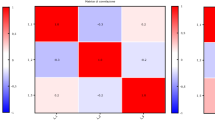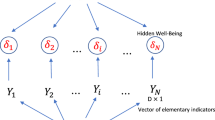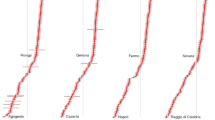Abstract
An interesting measure for equitable and sustainable well-being has been proposed recently by the National Institute of Statistics in Italy and the National Council for Economy and Labour. It is called BES (from the Italian Benessere Equo e Sostenibile). A set of indicators, partitioned into several domains and themes, is used for measuring the BES. Taking into account prior knowledge of both the structure of this set of indicators and the relationships among them, the paper proposes a hierarchical composite model for measuring and modeling the BES of the Italian provinces. This hierarchical model allows us to synthesize individual indicators into single indexes in order to construct composite indicators at a global and a partial level. Moreover, we analyze the relationships among the different domains and themes as well as the effects of these on equitable and sustainable well-being, in order to search for strongly influential factors. In order to estimate the parameters of the model, we use both Partial Least Squares path modeling and a new method, called Quantile Composite-based path modeling. In particular, Partial Least Squares path modeling is used to estimate average effects in the network of relationships between variables, while with Quantile Composite-based path modeling we investigate whether the magnitude of these effects changes across different parts of the variable distributions, providing a more complete picture and uncovering specific local leveraging factors for improvement. A final ranking of the Italian provinces, according to the BES composite indicator, is also provided at the national level and for different geographic areas of Italy.




















Similar content being viewed by others
Notes
The acronym NUTS (from the French ”Nomenclature des unités territoriales statistiques”—NUTS) stands for Nomenclature of Territorial Units for Statistics, that is the European Statistical System official classification for the territorial units. The NUTS is a partitioning of the EU territory for statistical purposes based on local administrative units. The NUTS codes for Italy have three hierarchical levels: NUTS1 (Groups of regions); NUTS2 (Regions); NUTS3(Provinces). The current NUTS 2013 classification is valid from 1 January 2015, and for Italy at the NUTS3 level it includes 110 territorial units, coinciding with the 110 provinces that existed in Italy at the reference date. During 2016, following the reform of the Local Authorities implemented by the Italian Government, some Provinces have become Metropolitan cities, while some others have been suppressed due to regional laws (in particular the Provinces of Sicily and Friuli-Venezia Giulia). As this changes have not yet been transposed into the statistical classification, in this paper, the term Provinces refers to the 110 units accounted in NUTS3, so including the new Metropolitan cities and the Provinces that no longer exist.
Politics and institutions, Research and Innovation and Quality of services.
The UrBes project is coordinated by Istat with the collaboration of the association of Italian municipalities. In 2015 about 30 Italian municipalities took part to UrBes 2015 Report (http://www.istat.it/urbes2015).
Statistical Information System of the Provinces’ BES is a project promoted by the Province of Pesaro and Urbino, with the Istat’s methodological and technical support. See the Italian National Statistical Programme, 2014–2016, updating to 2015 (PSU-00004). 25 Italian provinces and metropolitan cities took part in the project in 2015.
Design study ‘Analysis and evaluation of equitable and sustainable well-being of the provinces’; Italian National Statistical Programme, 2011–2013 (PSU-00003).
Life expectancy, safeguard from health vulnerability, education attainment, participation in education and competencies, lifelong learning, work participation, gender gap in labor market, safety at work, political participation, institutional representation, quality of environment, restraint of resource consumption
Health, Education and Training, Work and life balance, Economic well-being, Social relationships, Security, Landscape and cultural heritage, Environment, Research and Innovation, Politics and institutions, Quality of services.
“Other indicators of general relevance” and “Specific indicators” of the Provinces’ BES were excluded as pointed out in Sect. 2.2.
These domains include: Health, Education and Training, Work and life balance, Economic well-being, Social relationships, Security, Landscape and cultural heritage, Environment.
These domains include: Research and Innovation, Politics and institutions, Quality of services.
References
Albers, S., & Hildebrandt, L. (2006). Methodological problems in success factor studies - measurement error, formative versus reflective indicators and the choice of the structural equation model. Zeitschrift für betriebswirtschaftliche Forschung, 58(2), 2–33.
Alkire, S. (2012). Dimensions of Human Developmen. World Development, 30(2), 181–205.
Becker, J. M., Klein, K., & Wetzels, M. (2012). Hierarchical latent variable models in PLS-SEM: guidelines for using reflective-formative type models. Long Range Planning, 45(5), 359–394.
Chelli, F. M., Ciommi, M., Emili, A., Gigliarano, C., & Taralli, S. (2015). Comparing equitable and sustainable well-being (BES) across the Italian provinces. A factor analysis-based approach. Rivista Italiana di Economia Demografia e Statistica, Volume LXIX n. 3/4 Luglio-Settembre, pp. 61-73 www.sieds.it.
Chin, W. W. (1998). The partial least squares approach for structural equation modeling. In G. Marcoulides (Ed.), Modern Methods for Business Research (pp. 295–336). London: Lawrence Erlbaum Associates.
Cuspi-Istat, Il benessere Equo e Sostenibile delle province. Roma, Cuspi (2015). https://www.besdelleprovince.it/.
Davino C., Furno M., & Vistocco D. (2013). Quantile Regression: Theoryand Applications. Wiley Series in Probability and Statistics, Wiley, Chichester, West Sussex.
Davino C. (2014). Combining PLS path modeling and quantile regression for the evaluation of customer satisfaction. Italian Journal of Applied Statistics, 26(2) (in Press 2016).
Davino, C., Esposito Vinzi, V., & Dolce, P. (2016). Assessment and validation in quantile composite-based path modeling. In H. Abdi, V. Esposito Vinzi, G. Russolillo, G. Saporta, & L. Trinchera (Eds.), The multiple facets of partial least squares methods, Springer Proceedings in Mathematics & Statistics (Chap. 13, pp. 268). New York: Springer Verlag.
Davino, C., & Romano, R. (2014). Assessment of Composite Indicators Using the ANOVA Model Combined with Multivariate Methods. Social Indicators Research, 119(2), 627–646.
Davino, C., & Vinzi, V. E. (2016). Quantile composite-based path modeling. Advances in Data Analysis and Classification. Theory, Methods, and Applications in Data Sciencedoi:10.1007/s11634-015-0231-9.
Delvecchio, F. (1995). Scale di misura e indicatori sociali, Bari, Cacucci.
Diamantopoulos, A., & Winklhofer, H. M. (2001). Index construction with formative indicators: An alternative to scale development. Journal of Marketing Research, 38(2), 269–277.
Dolce, P., Esposito Vinzi, V., & Lauro, C. (2016). Path directions incoherence in PLS path modeling: a prediction-oriented solution. In H. Abdi, V. Esposito Vinzi, G. Russolillo, G. Saporta, & L. Trinchera (Eds.), The Multiple Facets of Partial Least Squares Methods, Springer Proceedings in Mathematics & Statistics (pp. 268) New York: Springer Verlag
Dolce, P., & Lauro, N. (2015). Comparing maximum likelihood and PLS estimates for structural equation modeling with formative blocks. Quality & Quantity, 49, 891–902.
Edwards, J. R. (2001). Multidimensional constructs in organizational behavior research: an integrative analytical framework. Organizational Research Methods, 4(2), 144–192.
e-Frame. (2013). European Framework for Measuring Progress, Measuring Progress at a Local level, workshop proceedings (deliverable 9.2), Pisa 25 July 2013, www.eframeproject.eu.
Vinzi, V. E., Chin, W.W., Henseler J., & Wang, H. (Eds.), Handbook of Partial Least Squares. Springer (2010).
European Statistical System (ESS). (2001). Summary Report from the Leadership Group (LEG) on Quality, Eurostat.
European Statistical System. (2001). Summary Report from the Leadership Group (LEG) on Quality, Eurostat.
Giovannini, E., Morrone, A., Rondinella, T., & Sabbadini, L. L. (2012). L’iniziativa Cnel-Istat per la misurazione del Benessere equo e sostenibile in Italia. Autonomie locali e servizi sociali, n. 1/2012, Il Mulino, Bologna.
Guinot, C., Latreille, J., & Tenenhaus, M. (2001). PLS path modeling and multiple table analysis. Application to the cosmetic habits of women in Ile-de-France. Chemometr. Intell. Lab. Syst., 58(2,) pp. 247–259.
Hair, J., Black, W., Babin, B., & Anderson, R. (2010). Multivariate Data Analysis. A Global Perspective. USA: Pearson Education Inc.
Hair, J. F., Hult, G. T. M., Ringle, C. M., & Sarstedt, M. (2014). A primer on partial least squares structural equation modeling (PLS-SEM). Thousand Oaks, CA: Sage.
Hall, J., Giovannini, E., Morrone A., & Ranuzzi, G. (2010). A framework to measure the progress of societies. In OECD Statistics Working Papers, 2010/5, OECD Publishing.
Istat. (2012). Linee guida per la qualità dei processi statistici.
Istat, Bes. (2013). Il benessere equo e sostenibile in Italia, Roma, Istat.
Istat. (2015). Il Benessere Equo e sostenibile in Italia, Roma, Istat. http://www.misuredelbenessere.it/.
Istat, UrBes. (2015). Il benessere equo e sostenibile nelle città, Roma, Istat.
Koenker, R., & Basset, G. (1978). Regression quantiles. Econometrica, 46, 33–50.
Koenker, R. (2005). Quantile regression. Cambridge: Cambridge University Press.
Li, G., Li, Y., & Tsai, C. (2014). Quantile correlations and quantile autoregressive modeling. Journal of the American Statistical Association, 110(509), 233–245.
Lohmöller, J. B. (1989). Latent variable path modeling with partial least squares. Heildelberg: Physica-Verlag.
Maggino, F. (Ed.) (2015). A new research agenda for improvements in quality of life. Springer International Publishing Switzerland, pp. 1–250.
Maggino, F., & Sorvillo, M. P. (2015). Going beyond GDP: A new challenge also for training statisticians. A new Master proposal and experience. In: New techniques and technologies for statistics, Brussels, March 9–13, Eurostat—European Commission, pp. 1–3.
Maggino, F. (2016). Challenges, needs and risks in defining wellbeing indicators. In: F. Maggino (Ed.) A life devoted to quality of life Festschrift in Honor of Alex C. Michalos, pp. 209–235, Switzerland: Springer International Publishing Switzerland.
Morrone, A., Scrivens K., Smith C., & Balestra C. (2011). Measuring Vulnerability and Resilience in OECD Countries. In IARIW-OECD Conference on Economic Insecurity, 1964. OECD Conference Centre in Paris, France.
OECD (2008) Handbook on constructing composite indicators: Methodology and user guide. Paris: OECD.
OECD. (2014). How’s life in your region? Measuring regional and local well-being for policy making. Paris. OECD.
ONS. (2011). Measuring what matters—National statistician’s reflections on the national debate on measuring national well-being.
Pintaldi, F. (2009). Come si analizzano i dati territoriali. Milano: Franco Angeli.
Riccardini F. (2015). Sustainability of wellbeing: The case of BES for Italy and SDGs Indicators. In Paper presented at the 60° ISI conference, Rio de Janeiro, 26–27 July, 2015.
Sabbadini, L. L. (2012a). La nuova sfida del BES. In Conferenza Nazionale di Statistica, Istat, Roma.
Sabbadini, L. L. (2012b). The path of BES: A new challenge for the measurment of quality of life. In: ISQLS Venezia.
Stiglitz, J., Sen, A., & Fitoussi, J. (2009). Report by the Commission on the Measurement of Economic Performance and Social Progress, Paris.
Taralli, S. (2013). Indicatori del Benessere Equo e Sostenibile delle Province: informazioni statistiche a supporto del policy-cycle e della valutazione a livello locale. Rassegna Italiana di Valutazione, A XVI, n. 55, Franco Angeli, Milano.
Taralli, S., Capogrossi, C., & Perri, G. (2015). Mesauring equitable and sustainable well-being (BES) for policy-making at local level (NUTS3). Rivista Italiana di Economia Demografia e Statistica, Volume LXIX n. 3/4, pp. 95–107, Luglio-Settembre. www.sieds.it.
Taralli, S., & D’Andrea, P. (2015). BES indicators at local level: Application to policy cycle and evaluation. In Measuring progress at a local level, Book of abstracts, University press, Pisa, pp. 13–16.
Tenenhaus, M., Vinzi, V. E., Chatelin, Y. M., & Lauro, C. (2005) PLS path modeling. In Computational statistics and data analysis, pp. 159–205.
Wetzels, M., Odekerken-Schröoder, G., & van Oppen, C. (2009). Using PLS path modeling for assessing hierarchical construct models: Guidelines and empirical illustration. MIS Quarterly, 33(1), 177–195.
Wilson, B., & Henseler, J. (2007). Modeling reflective higher-order constructs using three approaches with PLS path modeling: A Monte Carlo comparison. In Australian and New Zealand Marketing Academy Conference (pp. 791–800), Otago, Australia.
Wold, H. (1982). Soft modeling: The basic design and some extensions. In K. Jöreskog & H. Wold (Eds.), Systems under indirect observation (Vol. 2, pp. 1–54). Amsterdam: North-Holland.
Wold, H. (1985). Partial least squares. In S. Kotz & N. L. Johnson (Eds.), Encyclopedia of statistical sciences. New York: Wiley.
Zaiczyk, F. (2001). Il mondo degli indicatori sociali, Carocci, Roma.
Author information
Authors and Affiliations
Corresponding author
Additional information
The data used in this paper were produced by Istat under the Statistical Information System of the Provinces’ BES. The project has been promoted by the Province of Pesaro and Urbino and realized under the Istat’s methodological and technical coordination. It has also been supported by CUSPI (Coordination of Statistical Offices of the Italian Provinces). For more information see www.besdelleprovince.it.
Appendix
Appendix
Tables 3, 4, 5, 6, 7, 8, 9, 10, 11, 12, 13, 14 and 15.
Rights and permissions
About this article
Cite this article
Davino, C., Dolce, P., Taralli, S. et al. A Quantile Composite-Indicator Approach for the Measurement of Equitable and Sustainable Well-Being: A Case Study of the Italian Provinces. Soc Indic Res 136, 999–1029 (2018). https://doi.org/10.1007/s11205-016-1453-8
Accepted:
Published:
Issue Date:
DOI: https://doi.org/10.1007/s11205-016-1453-8




